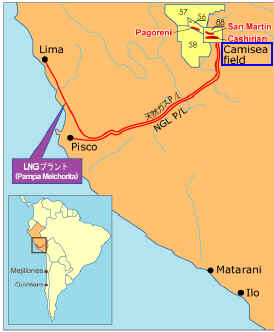Published Date: Nov 10
2010
Peru Petrochemicals
Report 2011 (Business Monitor International)
The
Camisea gas field
has the potential to provide enough ethane feedstock for at least one world-scale 1mn
tpa cracker. However, as of 2010 Peru had no production capacity
for basic petrochemicals such as ethylene, propylene or polymers
such as polyethylene and polypropylene. A small domestic market
would mean any development of the petrochemical sector would have
to
be export-oriented.
According to our forecasts, it is highly unlikely that Peru will
see olefins and polyolefins capacity coming onstream in the next
five years.
The only development in this area is the proposed JV by PetroPeru and Brazil's
Petrobras and Braskem to create a facility that will produce 700,000-1.2mn tpa
of PE.
Braskem says its plans for studying investments in Peru remain in
the MoU stage and by the end of 2010 had not advanced to the
planning stage. However, the availability of related gas now
appears to be even more attractive than it was when Braskem first
started studying the project more than in 2009, Braskem says.
However, the project has been pushed back by two years to 2016 as
investors wait for an increase in gas supplies. We are mindful
that past proposed petrochemical projects have not progressed and
that some plants may not get off the drawing-board.

Recent attention has focused on the development of the fertiliser sector.
Proposed projects could provide 2.41mn tpa of
ammonia capacity,
but we do not believe any of these projects will be completed
before 2015.
A Peruvian-Chilean consortium seeks to begin production at a
US$650mn petrochemicals plant in 2012, after the government
approved the project. Nitratos del Peru, a partnership between
Brescia group and Sigdo Koppers, states that the plant will
produce around 710,000tpa of ammonia and
350,000tpa of industrial-grade ammonium nitrate. The plant will be built in Pisco,
in the Ica region.
While the domestic petrochemicals market will remain small, it
will be stable with Peru's economy performing favourably in
regional and global terms. The main concern, as elsewhere, is the
downturn in construction, which is not being helped by the
deterioration of the investment climate amid heightened political
risk as the country approaches the 2011 elections. This could
knock the market in construction materials, notably PVC.
Nevertheless, private consumption growth levels will remain
relatively stable, albeit at a gentler rate, which will benefit
goods that utilise PE and PP.
@
The Camisea gas fields
were discovered in 1986 by Royal Dutch Shell.
A consortium of Shell and Mobil started to develop the fields,
but cancelled all projects in Peru in 1998, due to political
concerns.
The new developer became a consortium led by Pluspetrol and it
consist of Pluspetrol (27.2%), Hunt Oil Company of Texas (25.2%),
SK Corporation (17.6%), Repsol YPF (10%), Tecpetrol (10%), and
Sonatrach(10%).
The development plan was carried-out under the government of
President Alejandro Toledo and the gas fields became operational
in August 2004.
PLUSPETROL is one of the private E&P companies
in Latin America that has experienced the greatest
development in the last decades.
With its first operations in Argentina, the Company is, at
present, the fourth oil and gas producer in that country and
the largest producer of Peru.
Tecpetrol is an Argentine company whose principal
activities are oil and gas exploration and production as well
as the transport and distribution of gas and electricity.
There are two pipelines carrying natural gas from the
Camisea gas fields.
The 540-kilometre Camisea pipeline traverses through the steep
Andes mountains, and terminates within the Paracas National
Reservation (San Martin ) at the Pisco terminal. It passes
through the Malvinas plant, were liquefied petroleum gas (propane
and heavier liquids) is separated from natural gas. The pipeline
has capacity of 450 million cubic feet per day (13~10^6 m3/d).
The second 714-kilometre natural gas pipeline runs
from Malvinas along the coast to Lima and Callao for distribution
to residents and industries in the capital city. LPG is exported
through the Pisco terminal.
This pipeline system is operated by Transportadora de Gas
Peruano, a consortium of Tecgas, Pluspetrol, Hunt Oil Company, SK
Corporation, Sonatrach and Grana y Montero.
In April 2007, Suez Energy and Kuntur Gas Transport unveiled
rival proposals for pipelines to carry Camisea gas to southern
Peru.
